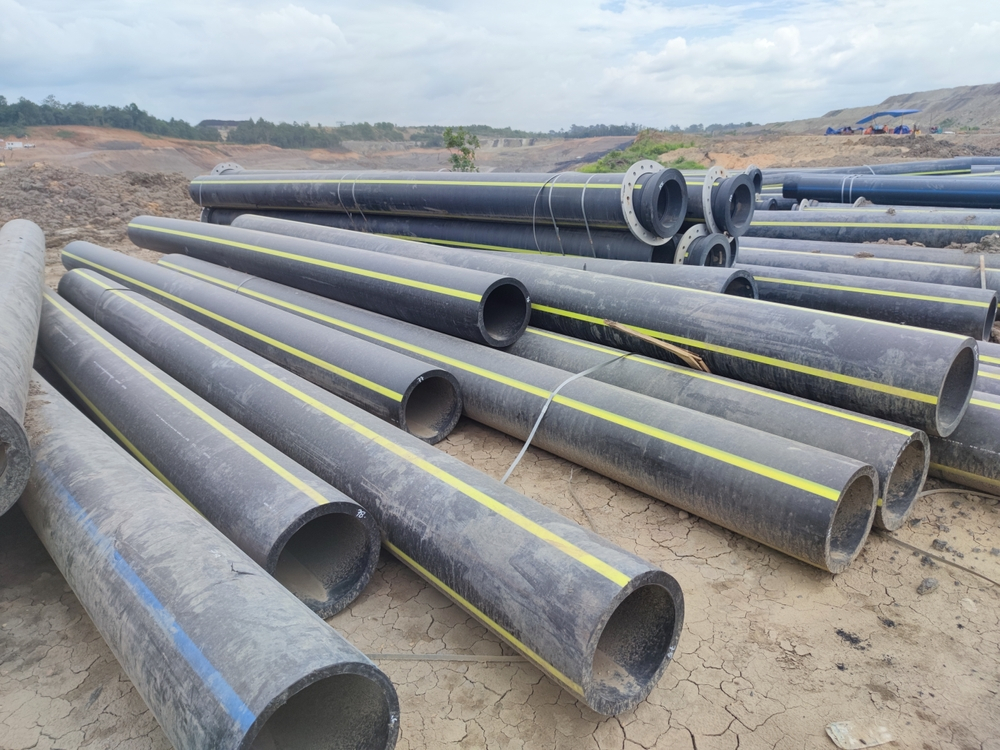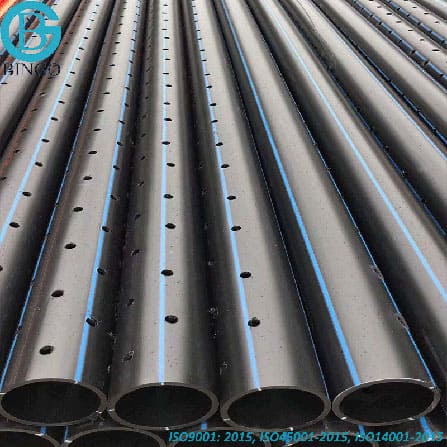In-Depth Look to hdpe pipe fittings Midland TX and Their Applications
Wiki Article
Check Out the Production Process Behind High-Quality HDPE Pipeline and Its Applications
The production process of premium HDPE pipelines is complex and systematic. It starts with the selection of resources that boost efficiency. Following this, ethylene undergoes polymerization to create resin, which is then shaped via extrusion. Quality assurance is critical, making sure that the last item fulfills strict standards. The trip of HDPE pipes doesn't finish with manufacturing. Their applications across numerous markets disclose a wider relevance worth checking out.Understanding HDPE: Properties and Advantages

High-density polyethylene (HDPE) is a flexible thermoplastic understood for its resilience and resistance to numerous environmental aspects. This material shows superb tensile stamina, making it suitable for demanding applications. Its low-density framework contributes to a lightweight product, assisting in simplicity of handling and installation. HDPE likewise showcases impressive resistance to chemicals, which reduces deterioration when subjected to harsh substances.
The product's reduced moisture absorption additionally improves its durability, making it suitable for usage in pipelines and tank. Furthermore, HDPE is resistant to ultraviolet (UV) radiation, guaranteeing that items maintain their honesty even when exposed to sunlight. Its versatility allows for the production of intricate forms without endangering strength. The green nature of HDPE, commonly obtained from recycled materials, adds to its allure, advertising sustainable practices in manufacturing. Overall, these residential or commercial properties and benefits make HDPE a recommended selection for various industrial and consumer applications.
Basic Material Selection for HDPE Manufacturing
The choice of basic materials for HDPE manufacturing is necessary to confirm the final item fulfills the preferred specifications and quality criteria. High-density polyethylene (HDPE) is mostly created from polymerized ethylene, originated from fossil fuels such as gas or petroleum. The high quality of these feedstocks significantly affects the mechanical and thermal residential properties of the last HDPE.Ingredients also play a significant function in boosting HDPE's efficiency, consisting of antioxidants, UV stabilizers, and colorants, which enhance longevity and resistance to environmental elements. The selection process have to take into consideration not only the chemical make-up of the raw products but likewise their processing features to ensure effective manufacturing.
The sourcing of raw materials need to focus on sustainability and conformity with ecological laws, as responsible methods are important in today's market. Inevitably, careful raw material option lays the foundation for creating top notch HDPE pipelines appropriate for varied applications.
The Extrusion Process: Forming HDPE Pipeline
The extrusion procedure plays an essential function in forming HDPE pipes, beginning with careful material prep work methods that assure suitable circulation and consistency. Just as vital is the design of the die, which straight influences the last measurements and surface high quality of the pipeline. Together, these aspects contribute considerably to the performance and high quality of HDPE pipeline production.Material Preparation Methods
Effective production of HDPE pipes begins with precise material prep work techniques, specifically the extrusion procedure. During this phase, high-density polyethylene material is initial dried out to get rid of moisture, making sure perfect circulation qualities. The material is after that fed right into the extruder, where it undertakes heating and melting, changing into a viscous state. This home heating procedure is meticulously controlled to keep the product's honesty and efficiency. The liquified HDPE is required through a die, shaping it right into a constant pipeline type. Appropriate temperature administration throughout extrusion is crucial, as it directly influences the material's buildings and the end product quality. As soon as shaped, the HDPE pipeline is cooled and reduced to specified lengths, prepared for subsequent handling and applications.Die Layout Value
Accuracy in die layout plays an essential role in the extrusion process of HDPE pipes. The die works as the final shaping device, directly affecting the pipe's measurements, wall thickness, and surface coating. A properly designed die guarantees consistent product flow, reducing problems such as irregularities and weak areas. The geometry of the die must be maximized to accommodate the particular buildings of HDPE, including its viscosity and thermal habits throughout extrusion. In addition, the cooling price of the material as it goes through the die can noticeably affect the pipe's structural integrity. Investing in advanced die modern technology is crucial for makers intending to create high-grade HDPE pipelines that satisfy sector requirements and customer assumptions.High Quality Control Procedures in HDPE Manufacturing
Various elements influence plumbing hot and cold water lines the top quality of HDPE pipe check my source manufacturing, efficient high quality control procedures are essential to ensure uniformity and dependability in the last product (hdpe pipe suppliers Midland TX). Key quality assurance methods consist of extensive product evaluation, validating that the raw polyethylene meets recognized requirements for purity and density. Throughout the extrusion process, parameters such as temperature, stress, and cooling time are very closely checked to preserve dimensional precision and architectural stabilityIn enhancement, post-production screening is crucial; suppliers frequently carry out hydrostatic examinations to assess the pipe's strength and resistance to pressure. Aesthetic inspections for surface area flaws even more improve quality control. Accreditation from pertinent requirements companies, like ASTM or ISO, gives an added layer of reputation. By applying these thorough top quality control steps, suppliers can reduce flaws, improve efficiency, and ensure that the HDPE pipes meet the particular requirements of different applications, inevitably bring about client contentment and count on the item.
Applications of HDPE Pipeline Throughout Industries
HDPE pipes are made use of throughout different markets other due to their resilience and versatility. In water circulation systems, they assure efficient delivery, while in wastewater administration, they supply reputable services for waste transport. Furthermore, farming watering networks benefit from HDPE's resistance to deterioration and flexibility, making it a suitable choice for modern farming techniques.
Water Circulation Systems
A significant number of markets count on high-density polyethylene (HDPE) pipes for effective water distribution systems. Known for their resilience and resistance to rust, HDPE pipelines are commonly used in municipal supply of water networks, farming irrigation, and industrial applications. Their light-weight nature assists in easy handling and installation, decreasing labor expenses and time. Furthermore, HDPE pipes can suit various pressure degrees, making them ideal for both low and high-pressure systems. Pipe Supplier American Plastics Midland. The adaptability of the product permits for smooth assimilation right into existing facilities, lessening the need for comprehensive excavation. HDPE's resistance to chemical leaching assurances that the water provided stays risk-free and tidy, making it an ideal selection for keeping the top quality of potable water throughout numerous industries.Wastewater Administration Solutions
Effective water circulation systems likewise lead the way for cutting-edge wastewater administration services, where high-density polyethylene (HDPE) pipes play a substantial role. Distinguished for their longevity and resistance to rust, HDPE pipelines are perfect for delivering wastewater in different settings. Their adaptability enables simple setup in intricate settings, lessening the demand for substantial excavation. Additionally, HDPE's smooth interior surface reduces friction, improving flow rates and efficiency. These pipes are additionally resistant to chemical leaching, making certain that pollutants do not jeopardize the surrounding environment. Industries, towns, and therapy centers significantly depend on HDPE pipes for their dependability and durability, making them a preferred option for contemporary wastewater administration systems. This adaptability emphasizes the crucial significance of HDPE pipes across many applications.Agricultural Watering Networks
Agricultural irrigation networks profit considerably from the use of high-density polyethylene (HDPE) pipes, which offer reliable and reliable water delivery to crops. HDPE pipelines are lightweight, making them very easy to carry and install, while their adaptability enables for different arrangements in diverse surfaces. These pipes show excellent resistance to deterioration, chemicals, and UV radiation, ensuring longevity in severe farming environments. In addition, their smooth interior surface area minimizes rubbing loss, maximizing water flow and minimizing energy costs related to pumping. The longevity of HDPE pipes, frequently exceeding half a century, adds to decrease upkeep and substitute expenses. Farmers progressively count on HDPE pipes to boost watering performance and promote sustainable agricultural techniques, inevitably leading to boosted plant returns and source conservation.
Future Fads in HDPE Pipe Technology
As the demand for lasting and reliable framework expands, advancements in HDPE pipe technology are positioned to transform numerous markets. Emerging patterns consist of the assimilation of smart modern technologies, such as sensing units and IoT capabilities, which promote real-time surveillance of pipeline conditions, decreasing upkeep costs and stopping leaks. Furthermore, the growth of advanced manufacturing techniques, such as 3D printing, is allowing the production of facility, tailored pipeline layouts that deal with particular task demands.Moreover, the concentrate on recycling and circular economic climate methods is driving the technology of HDPE pipes made from recycled materials, improving sustainability. Improved jointing methods, such as electro-fusion and mechanical fittings, are also improving setup performance and dependability. Finally, the growing focus on ecological guidelines is pressing makers to embrace greener manufacturing procedures, making sure that HDPE pipelines not only meet sector standards but additionally foster an even more sustainable future for infrastructure development.
Regularly Asked Questions
Just How Does HDPE Contrast to Other Plastic Materials?
HDPE outperforms several other plastic products concerning resilience, chemical resistance, and flexibility. Its low thickness and high tensile stamina make it ideal for various applications, usually surpassing options in both performance and durability.What Are the Ecological Effects of HDPE Manufacturing?
The environmental influences of HDPE production include greenhouse gas emissions, energy consumption, and potential pollution from producing processes. In addition, incorrect disposal can lead to dirt and water contamination, increasing issues concerning lasting ecological effects.Can HDPE Pipeline Be Recycled?
Yes, HDPE pipelines can be recycled. Lots of facilities approve utilized HDPE for handling, changing it right into new items. This reusing adds to sustainability efforts, reducing plastic waste while preserving sources and energy in the manufacturing cycle.What Is the Life Expectancy of HDPE Piping?

How Do Temperature Level Variations Impact HDPE Pipe Performance?
Temperature variations greatly influence HDPE pipeline efficiency, influencing flexibility and toughness. Heats can cause softening, while low temperatures might cause brittleness, eventually affecting the pipeline's resilience and suitability for different applications in diverse atmospheres.Report this wiki page